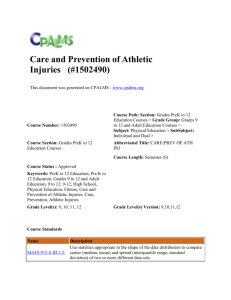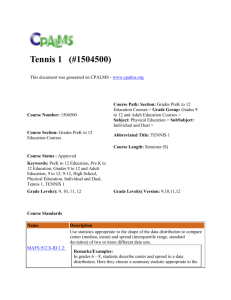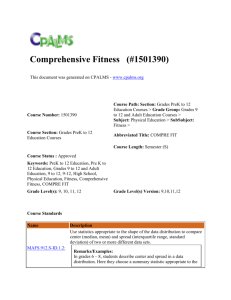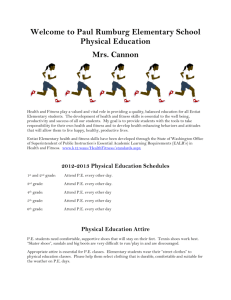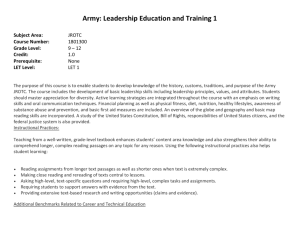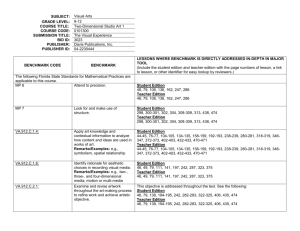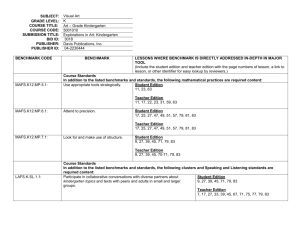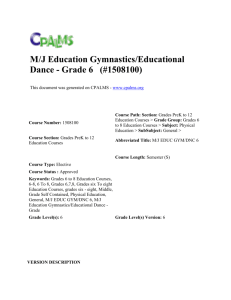Fitness Lifestyle Design (#1501310)
advertisement
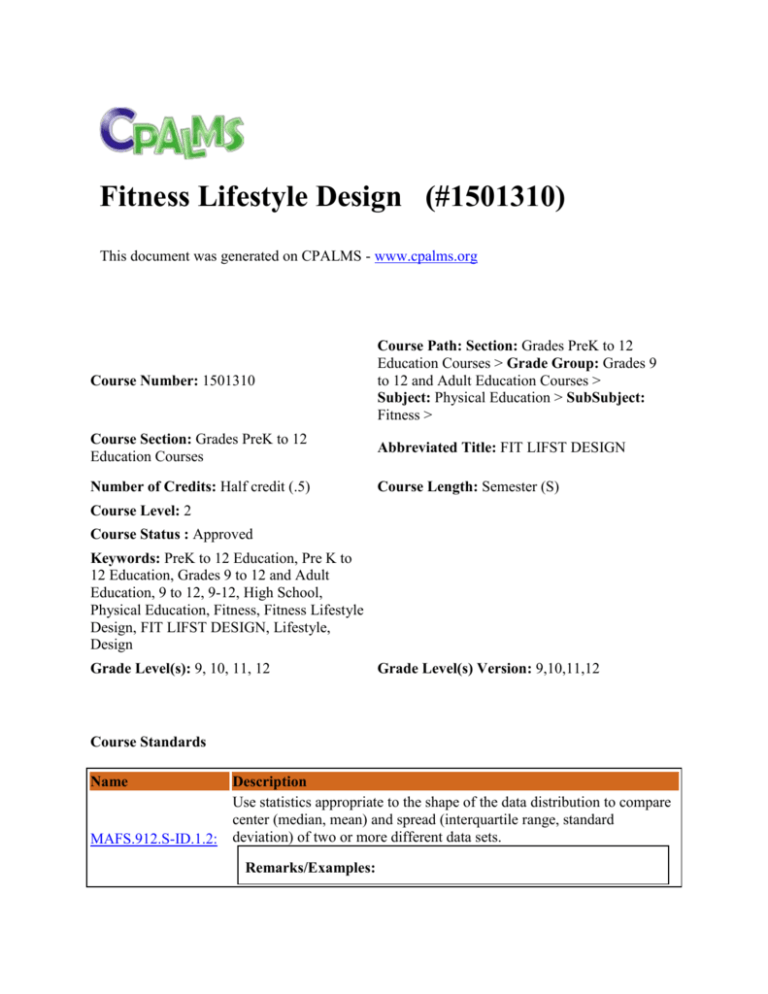
Fitness Lifestyle Design (#1501310) This document was generated on CPALMS - www.cpalms.org Course Number: 1501310 Course Path: Section: Grades PreK to 12 Education Courses > Grade Group: Grades 9 to 12 and Adult Education Courses > Subject: Physical Education > SubSubject: Fitness > Course Section: Grades PreK to 12 Education Courses Abbreviated Title: FIT LIFST DESIGN Number of Credits: Half credit (.5) Course Length: Semester (S) Course Level: 2 Course Status : Approved Keywords: PreK to 12 Education, Pre K to 12 Education, Grades 9 to 12 and Adult Education, 9 to 12, 9-12, High School, Physical Education, Fitness, Fitness Lifestyle Design, FIT LIFST DESIGN, Lifestyle, Design Grade Level(s): 9, 10, 11, 12 Grade Level(s) Version: 9,10,11,12 Course Standards Name MAFS.912.S-ID.1.2: Description Use statistics appropriate to the shape of the data distribution to compare center (median, mean) and spread (interquartile range, standard deviation) of two or more different data sets. Remarks/Examples: In grades 6 – 8, students describe center and spread in a data distribution. Here they choose a summary statistic appropriate to the characteristics of the data distribution, such as the shape of the distribution or the existence of extreme data points. MAFS.912.S-MD.2.7: LAFS.910.L.3.4: Analyze decisions and strategies using probability concepts (e.g., product testing, medical testing, pulling a hockey goalie at the end of a game). Determine or clarify the meaning of unknown and multiple-meaning words and phrases based on grades 9–10 reading and content, choosing flexibly from a range of strategies. a. Use context (e.g., the overall meaning of a sentence, paragraph, or text; a word’s position or function in a sentence) as a clue to the meaning of a word or phrase. b. Identify and correctly use patterns of word changes that indicate different meanings or parts of speech (e.g., analyze, analysis, analytical; advocate, advocacy). c. Consult general and specialized reference materials (e.g., dictionaries, glossaries, thesauruses), both print and digital, to find the pronunciation of a word or determine or clarify its precise meaning, its part of speech, or its etymology. d. Verify the preliminary determination of the meaning of a word or phrase (e.g., by checking the inferred meaning in context or in a dictionary). Determine the meaning of symbols, key terms, and other domain-specific LAFS.1112.RST.2.4: words and phrases as they are used in a specific scientific or technical context relevant to grades 11–12 texts and topics. PE.912.C.2.7: Evaluate the effectiveness of specific warm-up and cool-down activities. PE.912.C.2.10: Analyze long-term benefits of regularly participating in physical activity. Document food intake, calories consumed and energy expended through PE.912.C.2.13: physical activity and analyze the results. Apply appropriate technology and analyze data to evaluate, monitor PE.912.C.2.23: and/or improve performance. Analyze the mechanical principles as they apply to specific course activities. PE.912.C.2.24: Remarks/Examples: Some examples are balance, force and leverage. PE.912.C.2.25: PE.912.C.2.26: Analyze and evaluate the risks, safety procedures, rules and equipment associated with specific course activities. Evaluate skill patterns of self and/or partner by detecting and correcting mechanical errors. Compare and contrast how movement skills from one physical activity can be transferred and used in other physical activities. PE.912.C.2.27: PE.912.L.3.1: PE.912.L.3.5: PE.912.L.3.3: PE.912.L.3.4: PE.912.L.3.6: PE.912.L.4.7: PE.912.R.5.2: PE.912.R.5.4: PE.912.R.5.5: PE.912.R.6.2: PE.912.R.6.3: PE.912.M.1.5: PE.912.M.1.13: PE.912.M.1.14: Remarks/Examples: Some examples are volleyball and tennis serve, surfing and skate boarding. Participate in a variety of physical activities to meet the recommended number of minutes of moderate to vigorous physical activity beyond physical education on five or more days of the week. Identify the community opportunities for participation in a variety of physical activities. Identify a variety of activities that promote effective stress management. Identify the in-school opportunities for participation in a variety of physical activities. Identify risks and safety factors that may affect physical activity throughout life. Evaluate how to make changes in an individual wellness plan as lifestyle changes occur. Develop strategies for including persons of diverse backgrounds and abilities while participating in a variety of physical activities. Maintain appropriate personal, social and ethical behavior while participating in a variety of physical activities. Remarks/Examples: Some examples are respecting teammates, opponents and officials, and accepting both victory and defeat. Demonstrate appropriate etiquette, care of equipment, respect for facilities and safe behaviors while participating in a variety of physical activities. Analyze physical activities from which benefits can be derived. Remarks/Examples: Some examples of potential benefits are physical, mental, emotional and social. Analyze the roles of games, sports and/or physical activities in other cultures. Apply strategies for self improvement based on individual strengths and needs. Perform a student-designed cardiorespiratory enhancing workout. Utilize technology to assess, enhance and maintain health and skillrelated fitness levels. Remarks/Examples: Some examples of technology are Excel spreadsheets or web based programs to chart or log activities, heart rate monitors, videotapes or digital cameras. PE.912.M.1.15: PE.912.M.1.16: Select and apply sport/activity specific warm-up and cool-down techniques. Apply the principles of training and conditioning to accommodate individual needs and strengths. Remarks/Examples: Some examples of training principles are overload, specificity and progression. Demonstrate use of the mechanical principles as they apply to specific course activities. PE.912.M.1.34: PE.912.M.1.35: Remarks/Examples: Some examples are balance, force and leverage. Select proper equipment and apply all appropriate safety procedures necessary for participation. There are more than 96 related instructional/educational resources available for this on CPALMS. Click on the following link to access them: http://www.cpalms.org/PreviewCourse/Preview/4032
